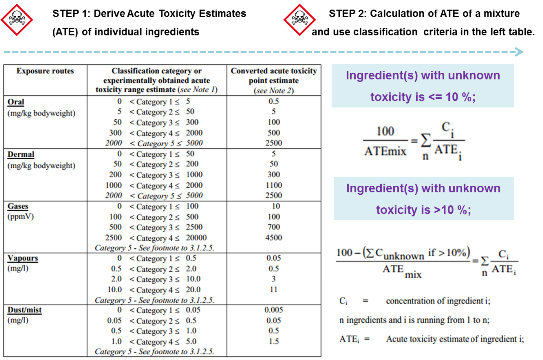Acute Toxicity Classification for Mixture (Acute Toxicity Estimate ATE Method)
Little Pro on 2019-02-09
Acute toxicity classification of a mixture is complicated. It happens very often that you do not have test data on the mixture as a whole or cannot apply GHS bridging principles to the un-tested mixture. In these cases, you have to classify the mixture based on the ingredients with known acute toxicity. In this article, we will explain the traditional Acute Toxicity Estimate (ATE) Method for classifying a mixture for its acute toxicity and give you two examples.
Acute Toxicity Estimate (ATE) Method
For a mixture containing a substance or more substances that have been classified as acutely toxic, you usually need to calculate the ATEs of the mixture first and then compare it against the classification criteria below to determine the acute toxicity category of a mixture. There are 2 equations to choose depending on whether the total concentration of ingredients with unknown toxicity is less than 10% or not.
How to Get Acute Toxicity Estimate (ATE) for Ingredient
To calculate the ATE of a mixture, you must get the ATE of all ingredients with known toxicity and the concentration of each ingredient first. The ATE of an ingredient is:
- an actual LD50 or LC50 value of the ingredient (if known) or
- a converted value from GHS acute toxicity category (based on the picture above).
Now let's see two real acute toxicity mixture classification examples.
Example 1: Ingredients with Known LD50 Values
Let's assume that we have a mixture containing the following ingredients. The total concentration of ingredients with unknown acute toxicity is less than 10%. Two ingredients have been classified as acutely toxic according to GHS and oral LD50 values are known. The rest 50% of ingredients do not have any acute toxicity.

In this case, we can directly use actual LD50 values as the ATE of ingredients and calculate the ATE of the mixture of containing them as below.

Since the calculated ATE of the mixture is between 50 mg/kg and 300 mg/kg, the mixture itself will be classified as acute oral toxicity category 3 (H301).
Example 2: Ingredients without Actual LD50 Values
Let's assume that we have a mixture containing the following ingredients. The total concentration of ingredients with unknown acute toxicity is less than 10%. Two ingredients have been classified as acutely toxic according to GHS. However, actual oral LD50 values are unknown.

In this case, we can only use converted value as the ATE of ingredients and calculate the ATE of the mixture of containing them as below. The corresponding ATE values of acute toxicity category 4 and category 2 are 500 mg/kg and 5 mg/kg respestively.

Since the calculated ATE of the mixture is between 5 mg/kg and 50 mg/kg, the mixture itself will be classified as acute oral toxicity category 2 (H300).
Classification and Labelling of Mixture Containing Ingredients with Unknown Acute Toxicity
When a mixture contains more than 10% of ingredients with unknown toxicity, you need to use a different equation. It should also be noted that:
- Where an ingredient with unknown acute toxicity is used in a mixture at a concentration >=1% and the acute toxicity estimates (ATE) of the mixture is calculated based on the acute toxicity data of known ingredients only (ATE method), a statement “x % of the mixture consist of ingredient(s) of unknown acute toxicity” may be required in SDS and on labels.
- The competent authority can decide whether the statement on ingredients of unknown acute toxicity should be communicated via labels or SDSs or both.
Read more: When to Label Ingredients of Unknown Acute Toxicity under GHS and How
More Readings
- GHS Precedence Rules for Pictogram, Signal Word and Hazard Statement
- GHS Classification of Mixture
- Global GHS Label Size Requirement
- Global GHS Label Requirement for Small Containers
- Does Your Country Limit the Number of P-statements on Labels
- How to Label Mixtures Containing Ingredients of Unkown Toxicity
- How to Use Precautionary Statements Correctly on GHS Labels
- How Shall You Label Mixtures Not Classified As Hazardous Under GHS
Having Questions?
We do not provide consultancy services. If you have questions or need any help, please contact our sponsor. You may also find an expert in CSP business directory below. If you are a consultant, you may get yourself listed in CSP business directory (free) or sponsor this page to leave your contact info on this page..

Tags: Topics - GHS, GHS Classification
